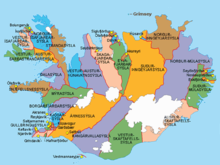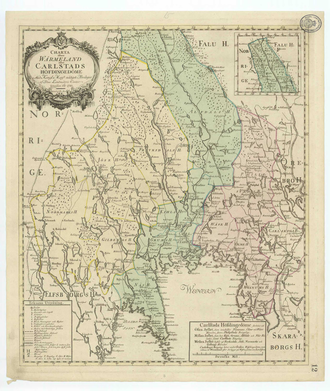Syssel
Syssel ( Danish , plural Sysler ) was a historical administrative unit in Jutland including the Duchy of Schleswig , Region Sjælland (Zealand), Norway and Sweden . Sysler still exist today in Iceland ( isl. Sýsla, plural sýslur) and on the Faroe Islands as police districts and in the sense of geographical regions.
etymology
The Scandinavian word syssel has its origins in Old Norse sýsla , sýsl ( f. ), Which means "work, employment" and can be traced back to Germanic * suhsla, * seuhsla ("pain, torment"). The Indo-European root is * seug- ("worried, sad, sick, sick"). Although the word in the Norse form had the transferred meaning “office, district”, neither officials nor administrations can be proven for the historical Sysler.
In today's Danish, syssel still means “work, employment” and is mostly only used in the historical context in its second meaning for the old Syslers. The older spelling is sysæl . I kongens sysæl means "on behalf of the king". In the great Gyldendals Røde Ordbog Dansk-Tysk (Danish-German) this second meaning no longer appears.
Emergence
The division into Sysler was a secular organizational principle. The administrative units had their origins in northern Jutland , where they were established in the 10th century. These oldest northern Syslers continued the old, grown tribal districts. The eastern areas had no ties to the pre-Danish population. In the south, place names were adopted for determination.
Compared to the harde ( herreder ), a syssel is the more recent historical form of organization. The Sysler have even adapted to the Harden limits. In Waldemars II's earth book , the Sysler are named as a middle, more geographical, subdivision between Harde and Land. The summary of several Harden under one Syssel contained in the Earth Book did not always coincide with the respective limits. Because of their geographical orientation, the Sysler lost its importance in the 13th century. They were comparable in time with the German districts of the 11th and 12th centuries.
A separate jurisdiction could not be proven for the Sysler . Rather, the seat of a thing was formed from the merging of several Harden into a Syssel. However, this did not result in sysselthing.
Jutland
The Jutland fifteen Sysler, each also including Harden , were called:
- Vendsyssel: In the northern part of today's Nordjyllands Amt on the island of Thy with the Harden Horns Herred, Vennebjerg Herred, Børglum Herred, Jerslev Herred, Hvetbo Herred and Kær Herred
- Thysyssel: In the western part of Thy Island in the northern Viborg Amt with the Harden Hillerslev Herred, Hundborg Herred, Hassing Herred and Refs Herred
- Sallingsyssel: In the southern Viborg Amt (Morsø Nørre Herred, Morsø Sønder Herred, Salling Nørre Herred, Harre Herred, Rødding Herred, Hindborg Herred and Fjends Herred)
- Himmersyssel: In the southern Nordjyllands Amt with the Harden Slet Herred, Hornum Herred, Fleskum Herred, Års Herred, Hellum Herred, Gislum Herred, Hindsted Herred and Rinds Herred
- Ommersyssel: In the northern Viborg Amt or in the south of Nordjyllands Amt with the Harden Nørlyng Herred, Sønderlyng Herred, Middelsom Herred, Onsild Herred, Nørhald Herred, Gerlev Herred and Støvring Herred
- Hardsyssel: corresponds roughly to today's Ringkjøbing Amt with the Harden Vandfuld Herred, Skodborg Herred, Hjerm Herred, Ginding Herred, Ulfborg Herred, Hammerum Herred, Hind Herred and Bølling Herred
- Åbosyssel: In the northern Viborg Amt with Harden Houlbjerg Herred, Galten Herred, Sønderhald Herred, Rougsø Herred, Djurs Nørre Herred, Djurs Sønder Herred, Mols Herred, Øster Lisbjerg Herred, Vester Herred, Lisbjerg Herred, Sabro Herlev Herred, Hredjel Frjern Frjern , Hasle Herred and Ning Herred
- Loversyssel: In the northern Vejle Amt with Lysgård Herred, Hids Herred, Vrads Herred, Tyrsting Herred, Nim Herred, Hatting Herred, Bjerre Herred, Voer Herred and Hads Herred
- Hansyssel with the Harden Hanherred
- Vardesyssel: corresponds roughly to Ribe Amt with the Harden Vester Horne Herred, Nørre Horne Herred, Øster Horne Herred, Skast Herred, Gørding Herred and Malt Herred
- Jellingsyssel: In the middle Vejle Amt with Harden Nørvang Herred and Tørrild Herred
- Almindsyssel: In the southern Vejle Amt with the Harden Jerlev Herred, Andst Herred, Brusk Herred, Holmans Herred and Elbo Herred
- Barvidsyssel: In northern North Schleswig with the Harden Tyrstrup Herred, Gram Herred (eastern half), Rangstrup Herreder and Haderslev Herred
- Ellumsyssel: In western and central Schleswig and along the west coast with the Harden Hviding Herred, Højer Herred, Lø Herred, Kær Herred, Slogs Herred, Rise Herred, Lundtoft Herred, Sundeved and a little from the eastern part of Søndre Rangstrup Herred
- Istedsyssel : In southern Schleswig with Harden Nørre & Sønder Gøs Herreder , Vis Herred , Ugle Herred , Husby Herred , Ny Herred , Strukstrup Herred , Slis Herred and Arns Herred .
The last three Sysler formed the Duchy of Schleswig from around 1200 . Other parts of the country were added to the area, which in their capacity as Danish crown property (Danish Kongelev ) were not Sysler, but which were attached to the Istedsyssel in Waldemar's earth book. They held a special position within the Danish Empire. These include:
- Schlei-Eider district with Fræzlæt (Fredslet) with the Risbyharde ( Schwansen peninsula ), Ykærnæburgh ( Eckernförde ), Hüttener Harde , Kroppharde , Stapelholm and the Danish Wohld
- Uthlande with the North Frisian Islands between Sylt and Eiderstedt ; they had been under royal rule for a long time (royal friezes).
Sjælland (Zealand)
The Sjælland region was divided into four syslers, which also consisted of Harden ( Herred ):
- Østersyssel: with Harden Strø, Holbo, Lynge, Jørlunde (senere Ølstykke), Sokkelund (Stynis), Smørum, Lille, Tune and Sømme.
- Medelsyssel: with Harden Horns, Voldborg, Ramsø, Bjæverskov, Stevns, Ringsted, Tybjerg and Alsted.
- Vestersyssel: with the Harden Flakkebjerg, Slagelse, Løve, Ars, Skippinge, Ods, Tuse and Merløse.
- Søndersyssel (including the islands of Møn , Falster and Lolland ): with the Harden Hammer, Fakse and Bårse, the four Harden of Lolland, as well as Møn and Falster (originally only one Harde).
See also
Norway
In the Middle Ages Norway was divided into 50 syslers, each of whom was headed by a syslamaðr (Sysselmann):
- Elfsysla: southern part of Bohuslen
- Ranrikesysla: northern part of Bohuslen, including Enningdalen in Østfold
- Borgarsysla: Østfold, except Enningdalen and Mossedal
- Oslosysla: Akershus with Oslo, as well as Lier
- Tunsbergsysla: Vestfold and Søndre Buskerud to Drammernfjorden.
- Skiensysla: Grenland, Telemark and Numedal
- Naumdølasysla
- Alstahaugsysla: Helgeland
- Bodinsysla: Folda, Salten
- Lofotensysla: Lofoten
- Steigensysla: Lødingen, Ofoten, Hammarøy and Steigen.
- Ylfissysla
- Andean Sysla:
- Trondenessysla: Troms
The area of East Greenland ( Eirik Raudes Land ) occupied by Norway from 1931 to 1933 was also called Syssel.
Today there is only one official with this title, that is the Sysselmann von Svalbard . In 1662 the term Syssel was abolished in Norway and replaced by (the Danish) office . Since 1919 these administrative units have been called Fylke .
Iceland
- see main article Administrative division of Iceland
There are 22 sýslur (singular sýsla ) in Iceland . The sýslur are also understood as geographical regions. You are not a political entity. There are only two levels of government in Iceland: the republic and the 79 municipalities.
Faroe Islands
The syslers in the Faroe Islands are called sýslur (singular: sýsla ) , as in Iceland . These are the six geographic regions:
In the past there was a separate ting in each sýsla, the so-called várting , and the parishes also corresponded to the Sysler ( for today's classification see Faroese People's Church ), but today there are only police circles , each headed by a Sýslumaður (Sysselmann). As in Iceland, the Faroese Sysler do not represent any political territorial units. There is only the Faroe Islands as a semi-autonomous state and the 30 municipalities . In contrast to Iceland, there is a higher level, the imperial level, to which Greenland also belongs in addition to the “motherland” Denmark .
Greenland
Before the administrative reform in Greenland on November 18, 1950, the previously separate Danish colonies or Landsrådene of West Greenland were divided into Sysler, which received Sysselräte ( Sysselråd ) from 1925 (status around 1944):
- South Greenland (Sydgrønlands Landsråd)
- Julianehaab Syssel
- Frederikshaab Syssel
- Godthaab Syssel
- Sukkertoppen Syssel
- Holsteinsborg Syssel
- North Greenland (Nordgrønlands Landsråd)
- Godhavn Syssel
- Egedesminde Syssel
- Christianshaab Syssel
- Jakobshavn Syssel
- Ritenbenk Syssel
- Umanak Syssel
- Upernavik Syssel
- East Greenland
- (no Syssel in East Greenland, only Angmaggsalik mission and Scoresbysund trading post)
Sweden
In Sweden, the term was only used in Värmland , which historically was divided into three syssels, Mellansysslet, Södersysslet and Östersysslet . called. The Syssel were divided into härader ( Harden ):
- Mellansysslets with Kil , Karlstad and Grums
- Södersysslets with Gillbergs and Näs
- Östersysslets with Färnebo, Ölme, Visnums and Väse
Web links
- Syslumenn.is - the Sysselmen in Iceland (in Icelandic)
- Map with Sysler in Denmark including Zealand
- Syssel in Den Store Danske Encyklopædi (Danish)
Individual evidence
- ^ Horst Windmann: Schleswig as territory. Wachholtz, Neumünster 1954, p. 45.
- ^ Horst Windmann: Schleswig as territory. Wachholtz, Neumünster 1954, pp. 44–47.
- ^ Horst Windmann: Schleswig as territory. Wachholtz, Neumünster 1954, p. 48.
- ^ Horst Windmann: Schleswig as territory. Wachholtz, Neumünster 1954, p. 38 u. Map 1, p. 221 (Appendix).
- ↑ Aage Brünner: Danmark Herreds-By og Birke Vaaben , approx. 1944, p. 25 Grønland (PDF; 19.4 MB)




